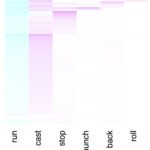Link to Pubmed [PMID] – 23803855
Proc. Natl. Acad. Sci. U.S.A. 2013 Jul;110(28):11261-6
Various insects and small animals can navigate in turbulent streams to find their mates (or food) from sparse pheromone (odor) detections. Their access to internal space perception and use of cognitive maps still are heavily debated, but for some of them, limited space perception seems to be the rule. However, this poor space perception does not prevent them from impressive search capacities. Here, as an attempt to model these behaviors, we propose a scheme that can perform, even without a detailed internal space map, searches in turbulent streams. The algorithm is based on a standardized projection of the probability of the source position to remove space perception and on the evaluation of a free energy, whose minimization along the path gives direction to the searcher. An internal “temperature” allows active control of the exploration/exploitation balance during the search. We demonstrate the efficiency of the scheme numerically, with a computational model of odor plume propagation, and experimentally, with robotic searches of thermal sources in turbulent streams. In addition to being a model to describe animals’ searches, this scheme may be applied to robotic searches in complex varying media without odometry error corrections and in problems in which active control of the exploration/exploitation balance is profitable.

